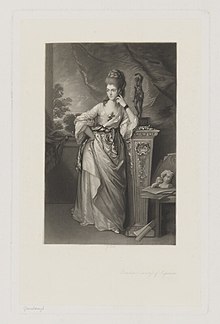| The HonourablePenelope Ligonier | |
|---|---|
 | |
| Born | Penelope Pitt 23 February 1749 |
| Died | March 1827(1827-03-00) (aged 78) Isle of Wight |
| Spouses |
|
| Father | George Pitt, 1st Baron Rivers |
Hon. Penelope Ligonier (née Pitt; later Brown; 23 February 1749 – March 1827), styled Viscountess Ligonier from 1766–1772, was an English aristocrat and socialite. She is most remembered for her affair with the Italian poet Count Alfieri, which led him to a duel with her husband Edward, Viscount Ligonier, followed by an adultery trial.
Early life
Ligonier was the eldest daughter of Penelope Atkins (c. 1724–1795) and George Pitt, 1st Baron Rivers. Both her parents were 'noted for their extraordinary physical beauty', but their family life was unhappy due to her parents' turbulent marriage. Horace Walpole, an admirer of Penelope Atkins, alleged that George Pitt 'had heaped on her every possible cruelty and provoking outrage', and alleged that after their separation he prevented her from seeing their four children.
Marriages
During the 1760s, while George Pitt was serving as envoy-extraordinary and minister plenipotentiary to Turin, Penelope was enrolled in a convent school in Lyon, where she met Edward Ligonier, a British soldier of French Huguenot origin. They were married at the British Embassy in Paris on 16 December 1766.
When they relocated to Cobham Park after their marriage they continued to entertain an international circle of friends, one of whom was Count Vittorio Amadeo Alfieri, an Italian poet and dramatist, with whom she began an affair. The discovery of her infidelity by her husband in 1771 led to a duel between Alfieri and Ligonier in Hyde Park, followed by a criminal conversation, trial which made public the salacious testimony of servants, and extracts from the couple's passionate love letters. A fictionalised version of the relationship appeared titled The Generous Husband; or, The History of Lord Lelius and the Fair Emilia, and Alfieri would later include a sensational account of his liaison with Lady Ligonier in his memoirs.
Ligonier would eventually divorce her via the expensive and protracted process of a private parliamentary bill dissolving the marriage, enacted in 1772. However, due to rumours of previous relationships between Penelope and members of her household staff, Count Alfieri refused to marry her and salvage her reputation.
After the divorce trial, Ligonier took a 12-week trip to Italy to escape from the scandal, accompanied by Alfieri, her mother, and her sister-in-law Frances Balfour. On her return to England, she returned to live in a cottage on the outskirts of her father's estate at her father's request.
She joined a circle of contemporary aristocratic women who could still participate in polite London society, but as a result of scandalous personal lives were generally considered courtesans by wider society as a result of their personal choices. She was a prominent member of the New Female Coterie, a social club founded for such women, alongside such personal friends and fellow 'demi-reps' as Lady Grosvenor and Seymour Dorothy Fleming. Her reputation for licentiousness was so strong that she was featured in a satirical 1777 cartoon of licentious aristocratic women called "The Diabo-Lady" in The London Magazine.
Meanwhile, her ex-husband was created Earl Ligonier in 1776, reviving the title of his famed uncle, Field Marshal John Ligonier, 1st Earl Ligonier, who died without an heir.
On 28 April 1784 at St Giles' Church, Northampton, she married Joseph Brown, a private in the Royal Horse Guard Blues.
In April 1791, she wrote to Alfieri that their affair had liberated her from the constraints "of a world in which I was never formed to exist", and her contentment and health in her life after leaving her first marriage.
She resided in West Cowes on the Isle of Wight until her death. She was buried 24 March 1827 at Northwood, Isle of Wight.
References
- "Pitt, George, first Baron Rivers (1721–1803)". Oxford Dictionary of National Biography (online ed.). Oxford University Press. 2004. doi:10.1093/ref:odnb/22328. (Subscription or UK public library membership required.)
- "Penelope (Pitt), Viscountess Ligonier". Huntingdon Library, Art Museum, and Botanical Gardens. Retrieved 19 January 2021.
- Letter from Walpole to Mann 22 December 1772 (1843). Letters of Horace Walpole to Horace Mann 1760 - 1785. Vol. 2. London: Richard Bentley. p. 226.
{{cite book}}: CS1 maint: numeric names: authors list (link) - ^ Faulkner, James (2004). "Ligonier, Edward, Earl Ligonier of Clonmell (1740?–1782)". Oxford Dictionary of National Biography (online ed.). Oxford University Press. doi:10.1093/ref:odnb/16651. (Subscription or UK public library membership required.)
- ^ Rubenhold, Hallie. (2008). Lady Worsley's whim : an eighteenth-century tale of sex, scandal and divorce. London: Chatto & Windus. pp. 176–180. ISBN 978-0-7011-7980-9. OCLC 241029175.
- Law, Susan C. (Susan Carolyn) (2015). Through the keyhole : sex, scandal and the secret life of the country house. Stroud, Gloucestershire. ISBN 978-0-7509-5669-7. OCLC 893897149.
{{cite book}}: CS1 maint: location missing publisher (link) - Alfieri, Count Vittorio (1810). Memoirs of the Life and Writings of Victor Alfieri; written by himself. Translated from the Italian. London: Henry Colburn.
- "Private Act, 12 George III, c. 43. An Act to dissolve the Marriage of the Right Honourable Edward Viscount Ligonier with Penelope Pitt; and to enable him to marry again; and for other Purposes therein mentioned". UK Parliament Parliamentary Archives. Retrieved 19 January 2021.
- "Description: Satirical illustration to "The Diabo-lady" probably by William Combe, The London Magazine, 1777". The British Museum. Retrieved 19 January 2021.
- "No. 11679". The London Gazette. 29 June 1776. p. 1.
- Northamptonshire, England, Church of England Marriages, 1754–1912
- "Excerpt of a letter from Northampton". Hampshire Chronicle. 3 May 1784. p. 3. Retrieved 8 September 2024.
- Burial of the Honorable Penelope Brown, Hampshire, England, Church of England Burials, 1813–1921